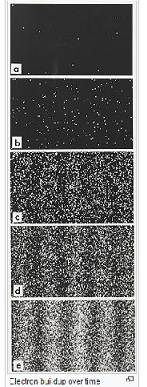I'm no quantum scientist. I'm just a software engineer with a healthy (?) fascination with quantum mechanics and knowledge gained from Googling. :) I've read many different articles about the double-slit experiment over many years. One I just read made something "click" in my head and I want confirmation, or at least discussion about it. The article (Are electrons waves or particles?) stated:
"The device interacts with the electron sufficiently to determine which slit, so the electron collapses down to a particle and goes through only one slit. Once past the barrier, the electron, freed from interaction, reverts to its wavy state. Upon interaction with the detection screen, it again collapses down to a particle and lands as a tiny localized dot."
For the first time it occurred to me that quantum particles are ALWAYS in a wave state except at the very moment they're interacted with.
So, in the double-slot experiment, the quantum particle is fired and travels from the "gun" to the slots in a wave state, spreading out from the gun, and goes through both slots, emerges from the slots as two waves, interferes with itself and then collapses to a particle when it interacts with the detection screen. In my mind, I see the "wave" instantly vanishing (it's spread out quite a ways in many directions by this point) and the particle "popping" into existence. I've heard the wave pattern described as a "probability" wave before, so in my mind, I see the interference wave pattern having higher "probability" in stripes (due to the interference) strongest directly across from the slots and getting weaker further from the slots. So the quantum particle "collapses" to a physical particle mostly where the probability in its wave pattern is strongest (directly across from the slot), but also (less frequently) sometimes in the less strong stripes, and mostly not in the areas between the stripes where the probability is the absolute lowest.
Add the observer at the slots to detect which slot it goes through. Again, the quantum particle is fired from the "gun" toward the two slots. It travels from the gun to the slots, but this time it's interacted with by the detectors. It instantly collapses to a physical particle at whichever slot its probability wave is strongest at? I'm guessing here. This is a point that I've never read described in a way that makes it clear to me or fits my "internal" mental model of how this works (which may be very wrong). At this point, the entire wave (which has been spreading out from the "gun") completely vanishes (stops propagating as if it never existed) and a physical particle appears at one of the slots. But the interaction that collapsed it is instantaneous (or at least a very small portion of time) and the particle immediately reverts back to a wave; but with a new "point of origin", the slot it was just forced to collapse at momentarily. Since now the wave is only originating from one of the slots, there's no interference with itself and so when it hits the detection screen, its point of strongest "probability" is directly across from the slot it originated from (after its momentary collapse and re-conversion back to a wave) and so it mostly hits directly across from the slots.
Am I way off base? Does this sound crazy? Or am I actually starting to get a better-than-normal grasp on this? If I'm on the right track, why have I never read it described this way before? There are areas I'm still unclear on, such as when the "wave" leaves the "gun" and the "waves" leave the "detectors" at the slots, they're both waves with probability. I think of some "interaction" happening at the slots that collapses the "gun" fired wave, but in reality (no pun intended), both waves are collapsing at some point. Since they're both just waves of probability, where does this interaction happen? Is it simply because their combined "probability" at the slot is highest so that's where they both mostly collapse?
Also, if I'm right, then if the detectors were placed a bit BEFORE the slots (between the "gun" and the slots), when the quantum particle (the one fired toward the slots) collapses and then re-converts back to a wave, wouldn't the wave have enough time to spread out again to the other slot (maybe weaker at the other slot?) and still interfere with itself? Maybe producing weaker stripes between and to either side of the slots on the detection screen than if the detectors weren't there?
Thanks for hearing me out. I had all this in my head after reading that article and having the epiphany that maybe quantum particles are ALWAYS in the wave state except for the brief moment of "interaction". This also has me thinking that everything I see is mostly in a wave state except for the brief moments a photon hits a particle in it. When that rare photon that hits a particle, collapsing it momentarily, and bouncing off it, hits my eye, long before my brain interprets that photon as "yellow", that particle has re-converted back to a wave... and probably collapsed and re-converted to a wave MANY times from other photons "interacting" with it. My mind is reeling with this possible new way to think of reality. I love it! Even if I'm totally wrong, it's so fun to think about it. :)


